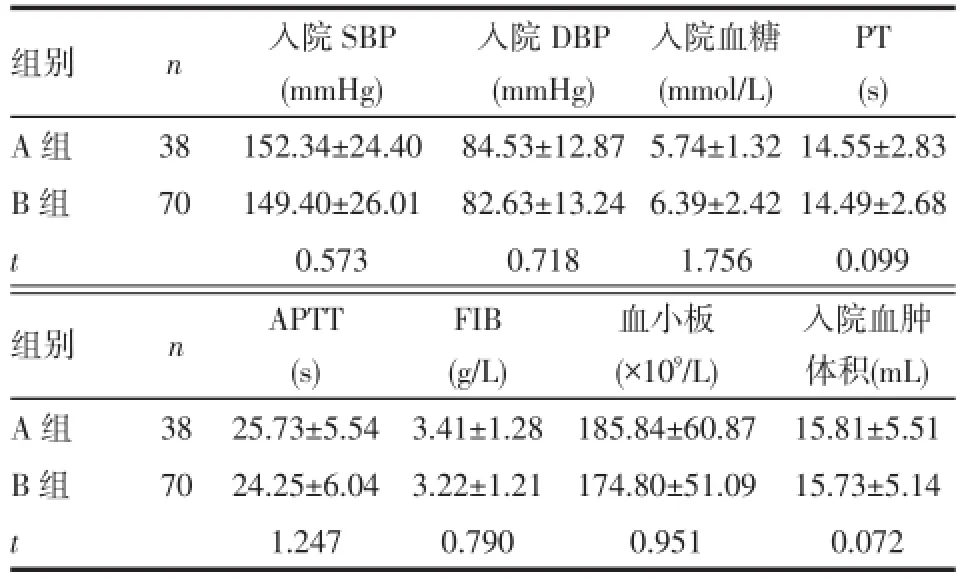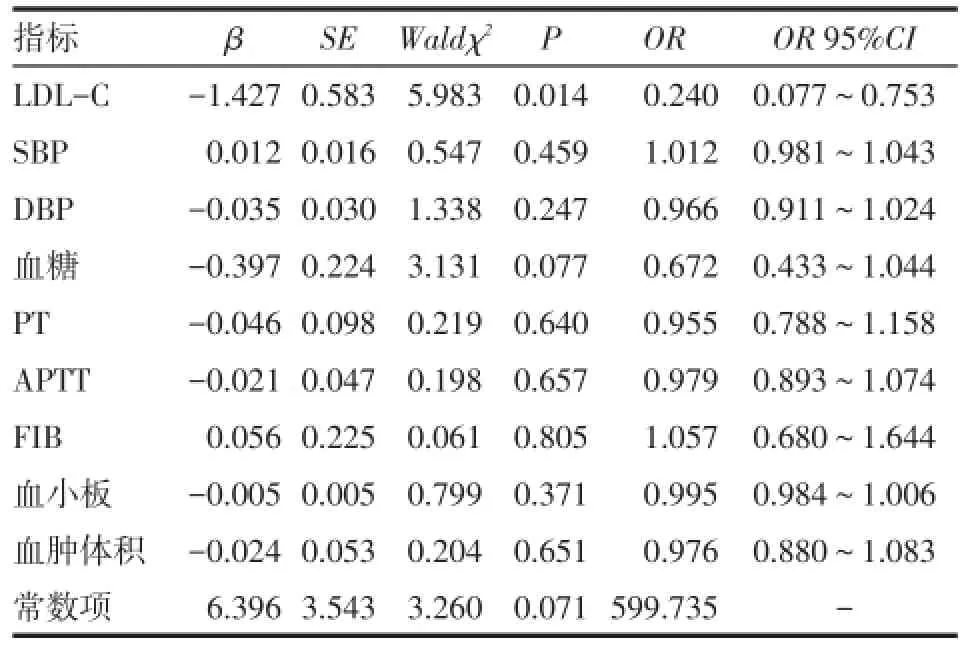血清LDL-C水平对老年男性高血压性脑出血血肿扩大的预测作用
周红霞,刘首峰,李玉旺,王欣,徐小林△
血清LDL-C水平对老年男性高血压性脑出血血肿扩大的预测作用
周红霞1,2,刘首峰3,李玉旺3,王欣3,徐小林3△
目的探讨血清低密度脂蛋白胆固醇(LDL-C)水平对老年男性高血压性脑出血急性期血肿扩大有无预测作用。方法收集我院2012年6月—2014年5月发病6 h以内的老年男性高血压性脑出血患者108例,按发病时LDL-C水平分为LDL-C<2.49 mmol/L组和LDL-C≥2.49 mmol/L组,对2组患者入院时的收缩压(SBP)、舒张压(DBP)、血糖水平、凝血酶原时间(PT)、部分活化凝血酶时间(APTT)、纤维蛋白原(FIB)、血小板计数、血肿体积进行对比分析,并于发病24 h复查头CT了解2组血肿扩大情况并进行比较。应用Logistic回归模型,寻找对脑出血血肿扩大有预测价值的危险因素。结果2组患者入院时SBP、DBP、血糖水平、PT、APTT、FIB、PLT、血肿体积比较差异无统计学意义;LDL-C<2.49 mmol/L组的血肿扩大发生率高于LDL-C≥2.49 mmol/L组(34.21%vs 11.43%,P<0.05)。Logistic多元回归分析显示,LDL-C<2.49 mmol/L是血肿扩大的危险因素。结论老年男性急性期高血压性脑出血患者LDL-C<2.49 mmol/L时提示血肿扩大风险较高,应及早采取相关治疗措施。
脂蛋白类,LDL;颅内出血,高血压性;血肿扩大;老年男性
高血压性脑出血的早期血肿扩大是临床中常见的现象,它增加了患者的致残率和病死率。预测及预防血肿扩大是降低患者致残率和病死率的关键环节,正日益受到临床医师的重视[1]。超早期检测血肿扩大的分子生物学标志物,有助于及早筛查出血肿易扩大的患者并给予针对性治疗。Rodri⁃guez-Luna等[2]的研究提示血清低密度脂蛋白胆固醇(LDL-C)水平可能与脑出血早期血肿扩大有关。笔者前期研究结果亦表明血清LDL-C与脑出血急性期血肿扩大有重要相关性[3]。随着人口老龄化的进展,老年人口所占比例越来越高,对于老年男性这一特殊群体,LDL-C能否预测高血压性脑出血急性期血肿扩大尚未得知。本研究采用前瞻性分析,连续收集2012年6月—2014年5月在我院就诊、发病6 h内的108例老年男性脑出血患者进行动态观察,探讨LDL-C水平对其脑出血血肿扩大有无预测作用。
1 资料与方法
1.1一般资料108例患者年龄60~85岁,平均(70.1± 10.2)岁。纳入标准:年龄≥60岁,经头CT证实,符合1995年全国第4次脑血管病学术会议制定的脑出血的诊断标准,所有患者均于发病后24 h复查头CT。排除标准:影像学检查提示继发于脑内异常结构的脑出血;6个月内有缺血性脑卒中发作的病史;伴随可能影响结果的相关疾病,如严重的呼吸系统疾病、晚期肿瘤、甲状腺功能亢进症、肝肾功能损害、严重心功能不全及内分泌疾病等;脑动脉瘤破裂出血;外伤后脑出血;单纯脑室出血;血液病及正使用抗凝药物等。研究对象经医院伦理委员会同意并签署知情同意书。
1.2方法
1.2.1血肿扩大的影像学评定由2名经验丰富的神经影像医师对头CT进行评价,以耳眦线为基线进行头CT连续扫描,根据多田公式计算血肿体积(mL)=Л/6×A×B×C(A:血肿最大出血平面的最长直径;B:与A垂直的直径;C:血肿高度)。血肿扩大的判定标准为血肿体积<20 mL时,前后2张头CT检查血肿体积增加>33%或血肿体积≥20 mL时,2张头CT检查血肿体积增加>10%[4]。
1.2.2实验室检查研究对象均进行入院时收缩压(SBP)、舒张压(DBP)、入院时血肿体积测定,并进行空腹采血,检测LDL-C、部分活化凝血酶时间(APTT)、凝血酶原时间(PT)、纤维蛋白原(FIB)、血小板计数、血糖。根据患者入院时LDL-C水平分为2组,LDL-C<2.49 mmol/L组(A组)和LDL-C≥2.49 mmol/L组(B组)。
1.2.3治疗方法所有患者入院后均采用脱水降颅压、改善脑代谢、控制血压及补液等对症治疗。
1.3统计学方法采用SPSS 17.0统计软件包进行分析,计量资料(符合正态分布)采用±s表示,2组间比较采用t检验;计数资料采用χ2检验,多元Logistic回归分析确定其危险因素,以P<0.05为差异具有统计学意义。
2 结果
2.1LDL-C≥2.49 mmol/L组和LDL-C<2.49 mmol/ L组一般资料比较2组患者入院时SBP、DBP、血糖、PT、APTT、FIB、血小板计数、入院时血肿体积比较差异均无统计学意义,见表1;发病24 h复查头CT血肿扩大LDL-C<2.49 mmol/L组(13/38)比例高于LDL-C≥2.49 mmol/L组(8/70),差异有统计觉得意义(χ2=8.161,P<0.05)。
Tab.1 Comparisons of baseline clinical data between two groups表1 LDL-C<2.49 mmol/L组和LDL-C≥2.49 mmol/L组患者一般资料比较 (±s)

Tab.1 Comparisons of baseline clinical data between two groups表1 LDL-C<2.49 mmol/L组和LDL-C≥2.49 mmol/L组患者一般资料比较 (±s)
*P<0.05;1 mmHg=0.133 kPa
组别A组B组t n 38 70入院SBP (mmHg)152.34±24.40 149.40±26.01 0.573入院DBP (mmHg)84.53±12.87 82.63±13.24 0.718入院血糖(mmol/L)5.74±1.32 6.39±2.42 1.756 PT (s)14.55±2.83 14.49±2.68 0.099组别A组B组t n 38 70 APTT (s)25.73±5.54 24.25±6.04 1.247 FIB (g/L)3.41±1.28 3.22±1.21 0.790血小板(×109/L)185.84±60.87 174.80±51.09 0.951入院血肿体积(mL)15.81±5.51 15.73±5.14 0.072
2.2LDL-C对脑出血血肿扩大的预测作用以血肿有无扩大(血肿无扩大=0,血肿扩大=1)作为因变量,以LDL-C水平(≥2.49 mmol/L=2,<2.49 mmol/L= 1)、入院时SBP、DBP、血糖、PT、APTT、FIB、血小板计数、血肿体积作为自变量,进行多因素Logistic回归分析,结果显示LDL-C<2.49 mmol/L是脑出血血肿扩大的危险因素,见表2。

Tab.2 Multiple Logistic regression analysis of risk factors of hemorrhage growth表2 血肿扩大影响因素的多因素Logistic回归分析
3 讨论
脑出血急性期血肿扩大在临床上十分常见,是脑出血急性期神经功能缺损加重的重要原因[5]。Rizos等[6]的研究表明脑出血血肿扩大多在发病后24 h,24 h后很少有血肿继续扩大的表现。因此,早期控制脑出血患者血肿扩大的危险因素,特别是发病后24 h,对防止血肿扩大有重要意义。鉴于此,本研究中亦采用了24 h界定有无血肿的扩大。老年男性高血压性脑出血是临床患者中非常重要的群体,本研究选择了这一特殊群体为研究对象,探讨LDL-C水平对老年男性高血压性脑出血血肿扩大有无预测作用。
如何判断急性脑出血患者血肿是否会继续扩大,从而在早期给予其针对性的治疗和处理,是神经科医师急需解决的问题。目前报道的影响高血压性脑出血早期血肿扩大的因素主要包括早期出血量的大小、出血形状、出血部位、高血压病、2型糖尿病、酗酒史、低纤维蛋白原血症、脑内微出血、C反应蛋白水平等[7-9]。笔者前期研究结果表明血清LDLC<2.49 mmol/L与脑出血急性期血肿扩大有重要相关性[3]。本研究显示LDL-C<2.49 mmol/L的患者中血肿扩大比例较高,多因素Logistic回归分析显示LDL-C<2.49 mmol/L是老年男性高血压性脑出血急性期血肿扩大的危险因素。Rodriguez-Luna等[2]报道,低LDL-C水平与急性高血压性脑出血早期血肿扩大、早期神经功能缺损症状加重及患者3个月预后有关,与本研究结果基本一致。Valappil等[10-11]的研究也提示低LDL-C水平可独立预测脑出血后早期血肿扩大和早期神经功能恶化,同时低LDL-C水平也是脑出血后病死率增高的独立危险因素。而国内关于LDL-C水平与高血压性脑出血早期血肿扩大关系的研究还较少。低水平LDL-C增加脑出血急性期血肿扩大的机制目前尚不完全清楚,可能与过低的LDL-C水平破坏小血管壁的完整性及导致血小板聚集下降有关[12-13],有待于今后研究明确。
综上,对老年男性患者这一特殊人群,发生急性脑出血时应及时检测血清LDL-C,特别是对于LDL-C<2.49 mmol/L者需要密切观察意识状态,及时复查头CT,以便及早采取相关治疗措施。本研究亦存在一定局限性,因临床实际情况,无法避免存在少数患者血肿急性期扩大但未到24 h复查头CT即死亡者,研究结论尚需通过进一步增加样本量并通过更为严谨的设计和前瞻性研究来证实。
[1]Brouwers HB,Chang Y,Falcone GJ,et al.Predicting hematoma ex⁃pansion after primary intracerebral hemorrhage[J].JAMA Neu⁃rol,2014,71(2):158-164.
[2]Rodriguez-Luna D,Rubiera M,Ribo M,et al.Serum low-density lipoprotein cholesterol level predicts hematoma growth and clinical outcome after acute intracerebral hemorrhage[J].Stroke,2011,42(9): 2447-2452.
[3]Liu SF,Xu XL.Relationship of serum low-density lipoprotein cho⁃lesterol level with hematoma growth after acute intracerebral hemor⁃rhage[J].China Journal of Modern Medicine,2013,23(16):85-87.[刘首峰,徐小林.血清低密度脂蛋白与脑出血血肿扩大的相关性研究[J].中国现代医学杂志,2013,23(16):85-87].
[4]Dowlatshahi D,Demchuk AM,Flaherty ML,et al.Defining hemato⁃ma expansion in intracerebral hemorrhage:relationship with pa⁃tient outcomes[J].Neurology,2011,76(14):1238-1244.
[5]Du Q,Yang DB,Shen YF,et al.Plasma leptin level predicts hema⁃toma growth and early neurological deterioration after acute intrace⁃rebral hemorrhage[J].Peptides,2013,45(1):35-39.
[6]Rizos T,Dörner N,Jenetzky E,et al.Spot signs in intracerebral hemorrhage:useful for identifying patients at risk for hematoma en⁃largement[J]?Cerebrovasc Dis,2013,35(6):582-589.
[7]Löppönen P,Qian C,Tetri S,et al.Predictive value of C-reactive protein for the outcome after primary intracerebral hemorrhage[J].J Neurosurg,2014,29(1):1-6.
[8]Kawano-Castillo J,Ward E,Elliott A,et al.Thrombelastography detects possible coagulation disturbance in patients with intracere⁃bral hemorrhage with hematoma enlargement[J].Stroke,2014,45 (3):683-688.
[9]Di Napoli M,Parry-Jones AR,Smith CJ,et al.C-reactive protein predicts hematoma growth in intracerebral hemorrhage[J].Stroke,2014,45(1):59-65.
[10]Valappil AV,Chaudhary NV,Praveenkumar R,et al.Low cholester⁃ol as a risk factor for primary intracerebral hemorrhage:A case-con⁃trol study[J].Ann Indian Acad Neurol,2012,15(1):19-22.
[11]Gu B,Zhao YC,Yang ZW,et al.HindIII polymorphism in the lipo⁃protein lipase gene and hypertensive intracerebral hemorrhage in the Chinese Han population[J].J Stroke Cerebrovasc Dis,2014,23 (6):1275-1281.
[12]Lee JG,Koh SJ,Yoo SY,et al.Characteristics of subjects with very low serum low-density lipoprotein cholesterol and the risk for intra⁃cerebral hemorrhage[J].Korean J Intern Med,2012,27(3):317-326.
[13]Valappil AV,Chaudhary NV,Praveenkumar R,et al.Low cholester⁃ol as a risk factor for primary intracerebral hemorrhage:A case-con⁃trol study[J].Ann Indian Acad Neurol,2012,15(1):19-22.
(2014-08-09收稿2014-10-24修回)
(本文编辑李国琪)
Clinic application of serum low-density lipoprotein cholesterol level in predicting expansion hematoma in elderly male patients with acute hypertensive intracerebral hemorrhage
ZHOU Hongxia1,2,LIU Shoufeng3,LI Yuwang3,WANG Xin3,XU Xiaolin3△
1Graduate School of Tianjin Medical University,Tianjin 300070,China;2Tianjin Hospital;3 Department of Neurology,Tianjin Huanhu Hospital
△Corresponding AuthorE-mail:hhyyxxl@163.com
ObjectiveTo investigate whether serum level of low-density lipoprotein cholesterol can predict the expan⁃sion of hemorrhage growth in elderly male patients with acute hypertensive intracerebral hemorrhage.MethodsPatients(n= 108)who visited our hospital with from June 2012 until May 2014 spontaneous hypertensive intracerebral hemorrhage with⁃in 6 hours of onset which is confirmed by initial computed tomography(CT)were sent to repeated CT within 24 hours of on⁃set.All selected patients were divided into the LDL-C≥2.49 mmol/L group and LDL-C<2.49 mmol/L group.Clinical data of these 2 groups were compared and the relationships of hematoma growth and its risk factors were analyzed.Results Baseline blood pressure,the level of blood glucose,PT,APTT,FIB,PLT and hemorrhage volume did not differ significantly between the LDL-C≥2.49 mmol/L group and LDL-C<2.49 mmol/L group.The ratio of hemorrhage growth in LDL-C<2.49 mmol/L group was significantly higher than that in LDL-C≥2.49 mmol/L group(34.21%vs 11.43%).Multiple logistic regres⁃sion analysis showed that LDL-C<2.49 mmol/L was the only risk factor contribute to hemorrhage growth.ConclusionPa⁃tients with LDL-C<2.49 mmol/L in acute intracerebral hemorrhage are of high risk of hemorrhage growth so early attention and appropriate procedure are needed to prevent or slow its growth.
lipoproteins,LDL;intracranial hemorrhage,hypertensive;hemorrhage growth;elderly men
R743.2
ADOI:10.11958/j.issn.0253-9896.2015.02.018
天津市卫生局科技基金项目(2012KZ033)
1天津医科大学研究生院(邮编300070);2天津市天津医院神经科;3天津市环湖医院神经内科
周红霞(1979),女,主治医师,硕士在读,主要从事脑血管病的诊断、治疗及康复的研究
△E-mail:hhyyxxl@163.com

